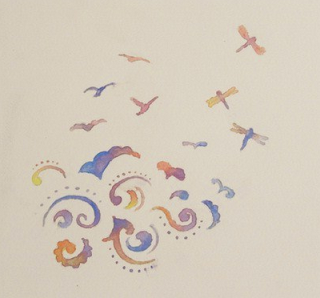Wake Up Happy
Cold, dark January, Monday mornings, and a messy bedroom. A recipe for a depressive mentality until at least 11am. I was determined to change this, and wake up happy. So I decided to make my bedroom wake-up-friendly.
 A bedroom is a place to relax, so despite my affinity for bright colours and loud, dramatic artwork, I decided to calm down and think outside the box. I went to Homebase (Richard's favourite - not.That experience was enough to make anyone want to relax...) I walked along the aisles of paint (Richard huffing and puffing behind me, desperate not to identify himself with any form of DIY). Ignoring my urges for plush purple and bright aqua, I turned my attentions to 'forgiving' colours - easy to look at, and let's face it - quite bland (they always look more extreme on the wall). I chose duck-egg blue.
A bedroom is a place to relax, so despite my affinity for bright colours and loud, dramatic artwork, I decided to calm down and think outside the box. I went to Homebase (Richard's favourite - not.That experience was enough to make anyone want to relax...) I walked along the aisles of paint (Richard huffing and puffing behind me, desperate not to identify himself with any form of DIY). Ignoring my urges for plush purple and bright aqua, I turned my attentions to 'forgiving' colours - easy to look at, and let's face it - quite bland (they always look more extreme on the wall). I chose duck-egg blue.
Then I chose my theme to compliment this. It's too easy to go for the same colour in the room's accessories, however too much of a colour can make you just sick to the back teeth of it. Also the room is quite small so I needed to break it up a little. I chose brown accessories and champagne silver. We luckily already had a luxury furry throw of exactly these colours so it looks great on the edge of the bed-frame.
To brighten the room a little, and emphasise space, I used mirrors from The Range - really good prices and lots of choice! I also added a couple of white ornaments from Dunelm Mill - the bird cage garland was £5 and the white wicker heart was just £3! These match well with the white-washed wall which blends to the ceiling. Leaving these walls white keeps the room bright and airy.
 I also bought some false flowers from Dunelm to match the white and champagne colour theme. These face the bed so that the first thing I see when I wake up is pretty.
I also bought some false flowers from Dunelm to match the white and champagne colour theme. These face the bed so that the first thing I see when I wake up is pretty.
To encourage low, subtle, calming lighting, I bought a table lamp. I hate using the main light in the bedroom - it's so harsh and unforgiving. The lamp was from Wilkinson's - such economy, wow!
To set a 'feeling' or 'theme' we added a rustic clock from Lightinthebox.com (it was Richard's idea to have a French Roman-Numeral one, which was part of his Christmas present). This added a shabby chic feel, and I threw in some furry cushions from Next. These were £14 each, and are so incredibly big and soft. I also included some soft brown plain ones from The Range.
My other accessories are items I already had, and felt complimented the feel of the room. They add to the 'ambience' and promote a little inspiration on a dull morning :)
And there we have it, a calm, inspiring and pretty room, with colours that compliment one-another and are easy on the eye. Waking up in this room is so much more peaceful and inspiring that the plain white room with a clothes-covered floor I was used to since we moved in!












